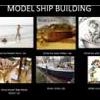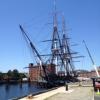-
Posts
5,635 -
Joined
-
Last visited
Reputation Activity
-
 wefalck got a reaction from JerseyCity Frankie in How was "Blackening the Guns" done on historic ships
wefalck got a reaction from JerseyCity Frankie in How was "Blackening the Guns" done on historic ships
Contemporary to whom ? To us or the time of the prototype ?
Actually, I don't think that bronze (not brass) guns where painted as the material is quite corrosion resistant and develops a protecting patina.
Cast iron and steel corrode differently, due to the graphite content in the former. I believe cast iron was often painted on an artificial patina. The controlled 'rusting' means a passivation and a better key for the paint than the bare iron.
When steel came into use in the second half of the 19th century, gun had become precision instruments that required a more controlled protection. The browing with vinegar etc. is not just throwing the acid over it, but it was applied carefully, sparing machined surfaces that had to retain their dimensions, such as seats for sightings, elevation mechanisms, or the rifling. However, some navies seem to have also painted their steel guns. In fact towards the end of the 19th century, when grey became ubiquitous, this became the general practice.
wefalck
-
 wefalck got a reaction from stelios in Lessons learned sewing sails
wefalck got a reaction from stelios in Lessons learned sewing sails
Personally, I don't like sewn sails. Particularly the hems tend to be grossly out of size, as the cloth thickness is way overscale.
Anyway, if you do insist to sew, it is helpful to pin (or glue) the cloth down onto a piece of silk paper (the type used to make carbon copies in the age of the typewriter). This prevents the cloth from being pulled out of shape by the machine. It also facilitates sewing a predetermined path (not always straight for sails !), because you can draw the pattern on it. The paper can be ripped out easily after the sewing has been completed.
On the same line, I have simulated in the past boltropes by reducing the stitching step to almost zero, i.e. to the diameter of the thread, stitching effectively a beading onto the cloth. The sail was cut out after the paper backing hat been ripped out. The beading can be stabilised with a bit of clear varnish to prevent it from becoming undone.
wefalck
-
 wefalck got a reaction from Modeler12 in How was "Blackening the Guns" done on historic ships
wefalck got a reaction from Modeler12 in How was "Blackening the Guns" done on historic ships
Contemporary to whom ? To us or the time of the prototype ?
Actually, I don't think that bronze (not brass) guns where painted as the material is quite corrosion resistant and develops a protecting patina.
Cast iron and steel corrode differently, due to the graphite content in the former. I believe cast iron was often painted on an artificial patina. The controlled 'rusting' means a passivation and a better key for the paint than the bare iron.
When steel came into use in the second half of the 19th century, gun had become precision instruments that required a more controlled protection. The browing with vinegar etc. is not just throwing the acid over it, but it was applied carefully, sparing machined surfaces that had to retain their dimensions, such as seats for sightings, elevation mechanisms, or the rifling. However, some navies seem to have also painted their steel guns. In fact towards the end of the 19th century, when grey became ubiquitous, this became the general practice.
wefalck
-
 wefalck got a reaction from dafi in How was "Blackening the Guns" done on historic ships
wefalck got a reaction from dafi in How was "Blackening the Guns" done on historic ships
Frome a late 19th century German source for steel guns: rub down the barrel repeatedly with vinegar. Once a firmly attached brown iron-oxide layer has developed, paint in lineseed oil. To be rubbed down with a cloth soaked in lineseed oil for maintenance. Be sure not let the vinegare etc. into the barrel (particularly in the case of rifled barrels).
This seems to implicate that the barrels were of a satin brownish colour, which is also evidenced by contemporary paintings.
Cast iron guns, according to the same source were to be painted in oil paint.
wefalck
-
 wefalck got a reaction from yvesvidal in Zuiderzee-Botter by wefalck - FINISHED - Artitec - RESIN
wefalck got a reaction from yvesvidal in Zuiderzee-Botter by wefalck - FINISHED - Artitec - RESIN
Continuation ...
The cast mast was nicely done by Artitec - in principle, but was too short for a boat of this size, did not have the right chocs for a boat from Marken and above all was warped. A new mast was fashioned on the lathe from a piece of steel rod - I did not have suitable stock of boxwood or similar and brass, aluminium or plexiglas would have not been stiff enough. The mast was turned in steps on the watchmakers lathe. This also allowed to turn-on the mast bands. It was then transferred to the dividing attachment (http://www.wefalck.eu/mm/tools/dividingapparatus/dividingapparatus.html) on the milling machine to mill on the squares. The various eyebolt and cranes were fashioned from copperwire and soldered or glued on.
As the mast, the boom was turned on the lathe from a 2 mm steel rod. The flexing of the rod was utilised to obtain the taper towards both ends.
Again the bands were turned on and the boom was tranfered to dividing apparatus for drilling the holes for eye bolts etc. The goose neck was turned from steel and the square, where it attaches to the boom, milled on using a very small end-mill.
The gaff has a rather odd, pear-shaped cross-section. In addition its longitudinal shape is rather crooked. It was fashioned from a piece of brass wire that was tapered off and bent to the right shape.
A piece of brass sheet was cut to follow the curve of gaff and hard-soldered to the brass wire. The pear-shape was filled-up with soft solder. Then the claws that were fashioned from brass were soldered on. Finally, the 0.2 mm holes for the line with which the sail is attached were drilled. The gaff was completed with various bands fashioned from partially flattened copper wire.
wefalck
-
 wefalck got a reaction from yvesvidal in Zuiderzee-Botter by wefalck - FINISHED - Artitec - RESIN
wefalck got a reaction from yvesvidal in Zuiderzee-Botter by wefalck - FINISHED - Artitec - RESIN
The leeboards are cast in resin, but due to the casting process in an open mold, their back is flat and without any sculpting. In reality, they are not just flat boards, but they have a cross-section almost like a propeller. In fact they are hollowed out over some part to create some hydrodynamic lift that counteracts the leeway and also pushes the leeboard against the boat. Using files and diamond rotary burrs the appropriate shape was given and also the separation of the individual boards of which the leeboards are composed were marked out.
There are various belaying clamps distributed around the hull. The kit has photoetched parts for these, but somehow they appear rather flat. In addition some or all of them would have to be of the single-horned variety, rather than the more common double-horned one, as
forseen in the kit. Replacements were milled raw from a strip of brass and sliced off on the lathe. They were finished using the hand-held power-drill using small grindstones and polishers.
Again, the casting of the hull is nicely done, but Artitec were a bit overenthusiastic in depicting a rather worn state. If there were such big gaps in the hull, the boat would sink to the bottom of the Zuiderzee like a sieve. To counteract the rather rustic appearance, fly-tying silk was glued as 'caulking' into the gaps using varnish.
wefalck
-
 wefalck got a reaction from yvesvidal in Zuiderzee-Botter by wefalck - FINISHED - Artitec - RESIN
wefalck got a reaction from yvesvidal in Zuiderzee-Botter by wefalck - FINISHED - Artitec - RESIN
Given the problems with the spill, it was cut completely from the moulded hull in order to be rebuilt as a separate item. Square holes and recessions cannot be easily machined from the solid. Therefore the spill was built up from a number of parts that would allow machining, The
0.5 mm x 0.5 mm holes for the handle bars were cut as slots into a section of 4 mm round brass bar.
The ratchet wheel was cut on the milling machine with a dividing attachment:
All parts had a 1 mm hole drilled through to take up a 1 mm brass rod. Brass was chosen in order to be able to soft-solder all parts together for the subsequent machining operations and to provide an axle.
The cigar-shape of the spill was turned with the Lorch free-hand turning device:
The piece was then transfered back to the dividing attachment (http://www.wefalck.eu/mm/tools/dividingapparatus/dividingapparatus.html)
on the mill and the eight sides of the winding drum were milled on.
Here the completed spill stem:
And installed in the hull:
to be continued ...
Wefalck
-
 wefalck got a reaction from Salty Sea Dog in Zuiderzee-Botter by wefalck - FINISHED - Artitec - RESIN
wefalck got a reaction from Salty Sea Dog in Zuiderzee-Botter by wefalck - FINISHED - Artitec - RESIN
Jules van Beylen (I think he was the conservator at the museum in Antwerp) has written many books on Dutch/Flemish boats and ships. There is also a monograph on the hoogars:
BEYLEN, J. VAN (1978): De hoogaars, geschiedenis en bouw.- 184 p. (De Boer Maritiem).
Most of the books cited above are packed with drawings. Van Beylen's books are actually written for modellers and have very detailed description for building a model in a 1/20 scale. Full size drawings seem to be available separately. Dorleijn's book contains also folded plates, but seems to have become extremely expensive over the past. I have almost all of the books cited in my library.
wefalck
-
 wefalck got a reaction from Salty Sea Dog in Zuiderzee-Botter by wefalck - FINISHED - Artitec - RESIN
wefalck got a reaction from Salty Sea Dog in Zuiderzee-Botter by wefalck - FINISHED - Artitec - RESIN
Here a couple of interesting books on botters and boeiers, albeit in Dutch:
CRONE, G.C.E. (1926): Nederlandsche Jachten, Binnenschepen Visschersvaartuigen en daarmee Verwante kleine Zeeschepen 1650 -1900.- 309 p., 85 Abb., Amsterdam (Swets & Zeitlinger, Nachdr. 1978 bei Schiepers, Schiedam). - with English translations.
BEYLEN, J. VAN (1985): De botter - Geschiedenis en bouwbeschrijving van een Nederlands visserschip.- 223 p., Weesp (De Boer Maritiem).
DORLEIJN, P. (2001): De Bouwgeschiedenis van de Botter. Vierendertig voet in de kiel.- 168 p., Lelystad (Uitgeverij Van Wijnen ).
KAMPEN, H.C.A. VAN, KERSKEN, H. (1927): Schepen die Voorbijgaan. Een verzamling Afbeeldingen en Beschrijvingen die de Nederlandsche Binnenwateren bevaren.- 351 p., Amsterdam (A.N.W.B. Toeristenbond voor Nederland).
OSTROM, C. van (1988): Ronde en platbodems schepen en jachten.- 144 p., Alkmaar (De Alk b.v.).
SOPERS, P.J.V.M. (196?): Schepen die verdwijnen (bearbeitet von H.C.A. van Kampen).- 162 p., Amsterdam (P.N. Van Kampen & Zon).
VERMEER, J. (2004): De Boeier. – 528 p., Alkmaar (De Alk & Heijnen Watersport).
wefalck
-
 wefalck got a reaction from ESF in Zuiderzee-Botter by wefalck - FINISHED - Artitec - RESIN
wefalck got a reaction from ESF in Zuiderzee-Botter by wefalck - FINISHED - Artitec - RESIN
Given the problems with the spill, it was cut completely from the moulded hull in order to be rebuilt as a separate item. Square holes and recessions cannot be easily machined from the solid. Therefore the spill was built up from a number of parts that would allow machining, The
0.5 mm x 0.5 mm holes for the handle bars were cut as slots into a section of 4 mm round brass bar.
The ratchet wheel was cut on the milling machine with a dividing attachment:
All parts had a 1 mm hole drilled through to take up a 1 mm brass rod. Brass was chosen in order to be able to soft-solder all parts together for the subsequent machining operations and to provide an axle.
The cigar-shape of the spill was turned with the Lorch free-hand turning device:
The piece was then transfered back to the dividing attachment (http://www.wefalck.eu/mm/tools/dividingapparatus/dividingapparatus.html)
on the mill and the eight sides of the winding drum were milled on.
Here the completed spill stem:
And installed in the hull:
to be continued ...
Wefalck
-
 wefalck got a reaction from avsjerome2003 in Tagua nuts for carving
wefalck got a reaction from avsjerome2003 in Tagua nuts for carving
Didn't know the English name of this nut, In German it is called Steinnuß, i.e. stone nut. The Latin name, Phytelephas macrocarpa, means big-fruit plant-ivory. I knew that until the middle of the 20th it was used to make buttons. Didn't know you could still buy it. Could also be an interesting material to make very small blocks from. By heat-treatment you seem to able to change the colour into a light brown,
wefalck
-
 wefalck got a reaction from capnharv2 in Turning cannon's
wefalck got a reaction from capnharv2 in Turning cannon's
The set-up and tools depends on the lathe you have, the size of the cannons, and on how many you have to make.
As one has to turn up to left and right shoulders as it where, i.e. to the bands, I would use a narrow straight tool. That is a tool that is 0.5 to 1 mm wide at the front and has side-relief ground into it. For brass there should be no top-rake, or it will 'dig in'.
People tend to make cannon from one piece, but, as you have to turn it around at some stage to finish both ends, they may be difficult to hold, because the profile is not cylindric, but conical, or even curved. Therefore, I would break down the design into two parts. The bands offer convenient separation points. Because the parts are shorter, you can probably also work without tailstock support, which makes working sometimes easier. The front part you can drill through a the calibre of the gun and in the back part you drill a blind hole with exactly the same diameter. A short piece of rod allows you to align the parts for soldering or glueing.
I would turn the basic shape using the slide rest and then finish off the rounded corners either using a file or a hand-graver. Again, the short sections make this operation easier. Finally, I would go over the pieces with steel wool while the lathe is running.
I would finish all the front parts and all the back part together, so that you can keep the same set-over for turning the conical parts.
Duplicators are probably nice (I never use one), but to make a good template is not that easy. I make myself a table or sketch of the slide-rest movements, so that I can repeat exactly the same movements for each part. This is akin to what a CNC-lathe would do under computer control.
When the guns are to be painted anyway, you may want to consider using Plexiglas/Perspex or aluminium as a material. I think it is cheaper than brass and lighter. Personally, I love to work with Plexiglas. It is also easy to glue and takes acrylic paints well.
wefalck
-
 wefalck got a reaction from captainbob in When were blocks changed?
wefalck got a reaction from captainbob in When were blocks changed?
Are you guys talking of sheaves or really of the axles, i.e. the pins on which the sheaves run ? I have never heard that the axles were made from anything else, but metal. The friction of wood on wood would be rather to high and they would very quickly wear down without constant greasing.
I think there has never been a complete shift over from wood to metal as far as blocks for organic and man-made fibres is concerned. The sheaves of blocks for wire rigging to my knowledge have (almost) always been from cast iron. The wire rope would simply saw into wooden sheaves. Also, wire rope requires relatively large sheaves that would be quite expensive to make from wood.
wefalck
-
 wefalck got a reaction from robin b in Hammocks, cranes and covers
wefalck got a reaction from robin b in Hammocks, cranes and covers
Thomas Ender made various coloured pencil drawings on board of SMS AUSTRIA during the passage to Brazil. The main purpose of the voyage was to take the austrian prinzess Leopoldine there to become the wife of the brazilian Emporer. Ender's artistic legacy is preserved in the Kupferstichkabinett of the Viennese Academy of Fine Arts. I have several books on Ender, but only one plate shows another deck view of SMS AUSTRIA.
As to the accessibility of the shrouds, I seem to have seen that in some instances a sort of net with a mesh-width similar to the ratlines was installed on the inside of the bulwark reaching to the top deadeyes to facilitate climbing into the shrouds.
wefalck
-
 wefalck got a reaction from Jaxboat in MicroMark MicroMill - Review
wefalck got a reaction from Jaxboat in MicroMark MicroMill - Review
Sherline et al. call their mills because they are mills. As I said, it has nothing to do with spindle speeds, only with the geometric arrangement of the machine tool - and the design of the spindle: a drilling machine is designed for axial forces, a milling machine for radial forces and axial forces on the spindle. The table of (co-odinate) drilling machines may also not be designed for being moved under load, i.e. for milling, though using it for light milling might be ok.
wefalck
-
 wefalck got a reaction from WackoWolf in MicroMark MicroMill - Review
wefalck got a reaction from WackoWolf in MicroMark MicroMill - Review
Sherline et al. call their mills because they are mills. As I said, it has nothing to do with spindle speeds, only with the geometric arrangement of the machine tool - and the design of the spindle: a drilling machine is designed for axial forces, a milling machine for radial forces and axial forces on the spindle. The table of (co-odinate) drilling machines may also not be designed for being moved under load, i.e. for milling, though using it for light milling might be ok.
wefalck
-
 wefalck got a reaction from WackoWolf in MicroMark MicroMill - Review
wefalck got a reaction from WackoWolf in MicroMark MicroMill - Review
The spindle speed has to be a function of cutter diameter and material to be worked. For a cutter of say of 50 mm diameter and working steel, you would go down to a few hundred RPM. Conversely, with a small router in wood you need probably 10k or 20k RPM to achieve a clean cut.
wefalck
-
 wefalck got a reaction from trippwj in In need of shipyard workers or boats crewmembers
wefalck got a reaction from trippwj in In need of shipyard workers or boats crewmembers
There are litterarly thousands of 54 mm or 1:32 scale figurines in either white metal or plastic (hard or soft) on the market. One has to look a bit around other fora for this. They come in whole figures or also as separate arms, bodies, heads etc. Some imaginative surgery will be needed probably. The Tamiya plastic soldiers are 1:35 scale and visibly smaller and more delicate than the 1:32 scale figures and in comparison there is a much smaller range. The 54 mm scale market covers all ages and subjects.
The G-gauge has a scale of 1:22.5 BTW. I have never heard of any 1:29 scale.
wefalck
-
 wefalck got a reaction from EricWilliamMarshall in Micro Blocks
wefalck got a reaction from EricWilliamMarshall in Micro Blocks
Such drills can be purchased with either 1 mm or 1.5 mm shafts from jewellers and clockmakers supply houses, or with 2.35 mm shaft from some jewellers or from modellers supply houses. The smallest drills with 2.35 mm shaft though are 0.5 mm. The others go right down to 0.1 mm. These ground drills are pricey, but their concentricity is much better than the rolled ones where the shaft diameter = drill diameter.
You may also want to look out for carbide drills with a 2.35 mm shaft on ebay, which often come cheaply from the aerospace or printed circuit board industries. They are used and replaced as part of preventive maintenance, but still good enough for our purposes. They run very well, but are rather fragile, so ou have to use them in a drill press.
wefalck
-
 wefalck got a reaction from dafi in Tiny Thimbles
wefalck got a reaction from dafi in Tiny Thimbles
I have used slices of cored soldering tin in the past. The flux can be washed out with acetone and the soft material allows it to be 'forged' into the required shape.
However, for my current project that will be mainly rigged with 0,2 mm home-made rope (in 1/90 this translates to 18 mm diameter, which is a diameter that can be handled well under all weather conditions) these thimbles would be still too big. I think, I will be filling in the eye-splices with lacquer and then drill a hole through. They will be coloured by turning a sharp pencil in them, which gives a sort of metallic finish, looking as if they have been zinc-coated.
wefalck














.thumb.jpeg.fc5d633a7b34428fcf19419a73d56d55.jpeg)